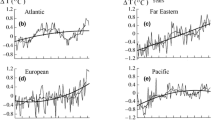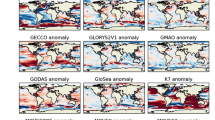Abstract
The heat distributions in the upper layers of the ocean have been studied and some important low frequency oscillations (LFOs) are already found and quantified by using various characteristic factors. In this paper, the ‘heat center’ of a sea area is defined with a simple method. Then the temperature data set of the upper layer of the global ocean (from surface down to 400 m, 1955–2003) is analyzed to detect the possible LFOs. Not only some zonal LFOs, which were reported early, but also some strong LFOs of the vertical and meridional heat distribution, which might imply some physical sense, are detected. It should be noted that the similar vertical oscillation pattern can be found in the Pacific Ocean, Atlantic Ocean and Indian Ocean. Results from some preliminary studies show that the vertical LFO might be caused by the solar irradiance anomalies. This study may help reveal some unknown dynamical processes in the global oceans and may also benefit other related studies.
Similar content being viewed by others
References
Cook, E. R., D. M. Meko, and C. W. Stockton, 1997. A new assessment of possible solar and lunar forcing of the bi-decadal drought rhythm in the Western United States.J. Clim.,10: 1343–1356.
Ho, C. R., X. H. Yan, and Q. A. Zheng, 1995. Satellite observations of upper-layer variabilities in the Western Pacific warm pool.Bull. Am. Meteorol. Soc.,76: 669–679.
Mann, M. E., and J. Park, 1996. Joint spatio-temporal modes of surface temperature and sea level pressure variability in the Northern Hemisphere during the last century.J. Clim.,9: 2137–2162.
Mantua, N. J., S. R. Hare, Y. Zhang, J. M. Wallace, and R. C. Francis, 1997. A Pacific interdecadal oscillation with impacts on salmon production.Bull. Am. Met. Soc.,78: 1069–1079.
Rebert, J. P., J. R. Donguy, G. Eldin, and K. Wyrtki, 1985. Relations between sea level, thermocline depth, heat content, and dynamic height in the tropical Pacific Ocean.J. Geophys. Res.,90: 11719–11725.
Tourre, Y. M., B. Rajagopalan, Y. Kushnir, M. Barlow, and W. B. White, 2001. Patterns of coherent decadal and interdecadal climate signals in the Pacific Basin during the 20 th century.Geophys. Res. Lett.,28: 2069–2072.
White, W. B., J. Lean, D. R. Cayan, and M. D. Dettinger, 1997. A response of global upper ocean temperature to changing solar irradiance.J. Geophys. Res.,102: 3255–3266.
Yan, X.-H., Y. Zhou, J. Pan, D. Zheng, M. Fang,et al., 2002. Pacific warm pool excitation, earth rotation and El Niño southern oscillations.Geophys. Res. Lett.,29 (21): 2301–2304.
Author information
Authors and Affiliations
Corresponding author
Rights and permissions
About this article
Cite this article
Mingqiang, F. Low frequency oscillations of the heat distribution in the global upper ocean layers. J. Ocean Univ. China 5, 35–38 (2006). https://doi.org/10.1007/BF02919370
Received:
Accepted:
Issue Date:
DOI: https://doi.org/10.1007/BF02919370




